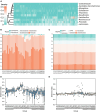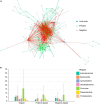High diversity, close genetic relatedness, and favorable living conditions benefit species co-occurrence of gut microbiota in Brandt's vole
- PMID: 38384265
- PMCID: PMC10879610
- DOI: 10.3389/fmicb.2024.1337402
High diversity, close genetic relatedness, and favorable living conditions benefit species co-occurrence of gut microbiota in Brandt's vole
Abstract
Introduction: Revealing factors and mechanisms in determining species co-existence are crucial to community ecology, but studies using gut microbiota data are still lacking.
Methods: Using gut microbiota data of 556 Brandt's voles from 37 treatments in eight experiments, we examined the relationship of species co-occurrence of gut microbiota in Brandt's voles (Lasiopodomys brandtii) with genetic distance (or genetic relatedness), community diversity, and several environmental variables.
Results: We found that the species co-occurrence index (a larger index indicates a higher co-occurrence probability) of gut microbiota in Brandt's voles was negatively associated with the genetic distance between paired ASVs and the number of cohabitating voles in the experimental space (a larger number represents more crowding social stress), but positively with Shannon diversity index, grass diets (representing natural foods), and non-physical contact within an experimental space (representing less stress).
Discussion: Our study demonstrated that high diversity, close genetic relatedness, and favorable living conditions would benefit species co-occurrence of gut microbiota in hosts. Our results provide novel insights into factors and mechanisms that shape the community structure and function of gut microbiota and highlight the significance of preserving the biodiversity of gut microbiota.
Keywords: biodiversity; density dependency; phylogenetic relatedness; social stress; species co-occurrence.
Copyright © 2024 Cheng, Li, Yang, Zhao, Liu, Zheng and Zhang.
Conflict of interest statement
The authors declare that the research was conducted in the absence of any commercial or financial relationships that could be construed as a potential conflict of interest.
Figures



Similar articles
-
Association between Capillaria hepatica infection-induced alterations in gut microbiota and estrogen expression in Brandt's voles (Lasiopodomys brandtii).BMC Vet Res. 2025 Mar 1;21(1):126. doi: 10.1186/s12917-025-04524-2. BMC Vet Res. 2025. PMID: 40025543 Free PMC article.
-
Effects of Different Levels of Flea Infestation on Gut Microbiota of Brandt's Voles (Lasiopodomys brandtii) in China.Animals (Basel). 2025 Feb 25;15(5):669. doi: 10.3390/ani15050669. Animals (Basel). 2025. PMID: 40075951 Free PMC article.
-
Gut microbiota reflect the crowding stress of space shortage, physical and non-physical contact in Brandt's voles (Lasiopodomys brandtii).Microbiol Res. 2021 Nov 23;255:126928. doi: 10.1016/j.micres.2021.126928. Online ahead of print. Microbiol Res. 2021. PMID: 34883384
-
Tannic Acid Induces Intestinal Dysfunction and Intestinal Microbial Dysregulation in Brandt's Voles (Lasiopodomys brandtii).Animals (Basel). 2023 Feb 7;13(4):586. doi: 10.3390/ani13040586. Animals (Basel). 2023. PMID: 36830373 Free PMC article.
-
High housing density increases stress hormone- or disease-associated fecal microbiota in male Brandt's voles (Lasiopodomys brandtii).Horm Behav. 2020 Nov;126:104838. doi: 10.1016/j.yhbeh.2020.104838. Epub 2020 Sep 3. Horm Behav. 2020. PMID: 32791065
Cited by
-
A new perspective in intestinal microecology: lifting the veil of exercise regulation of cardiometabolic diseases.Gut Microbes. 2024 Jan-Dec;16(1):2404141. doi: 10.1080/19490976.2024.2404141. Epub 2024 Sep 21. Gut Microbes. 2024. PMID: 39305272 Free PMC article. Review.
-
Research Progress in Biodiversity and Human Well-Being, Based on CiteSpace.Biology (Basel). 2024 Dec 6;13(12):1020. doi: 10.3390/biology13121020. Biology (Basel). 2024. PMID: 39765687 Free PMC article. Review.
References
-
- Batsuren E., Zhang X., Song M., Wan X., Li G., Liu J., et al. (2022). Density-dependent changes of mating system and family structure in Brandt’s voles (Lasiopodomys brandtii). Ecol. Evol. 12:e9199. 10.1002/ece3.9199 - DOI
LinkOut - more resources
Full Text Sources

